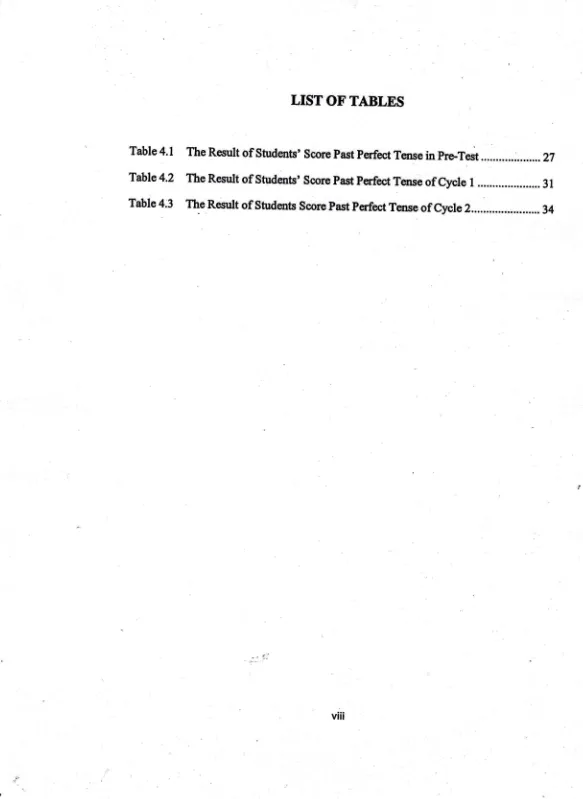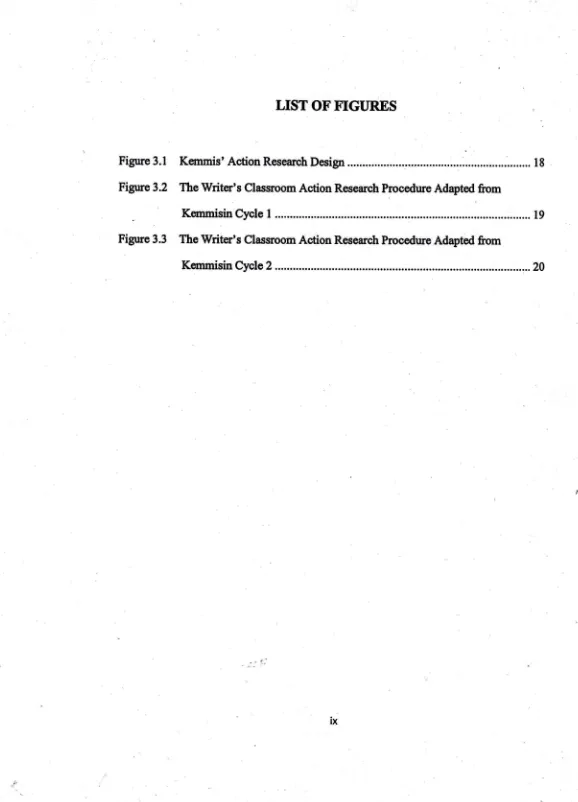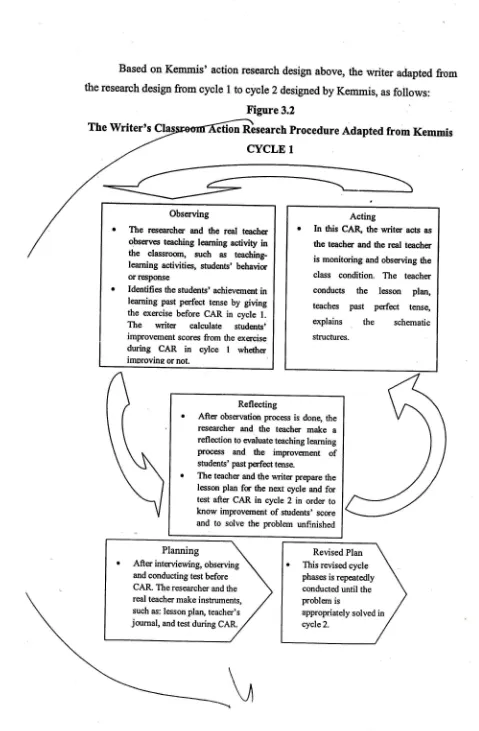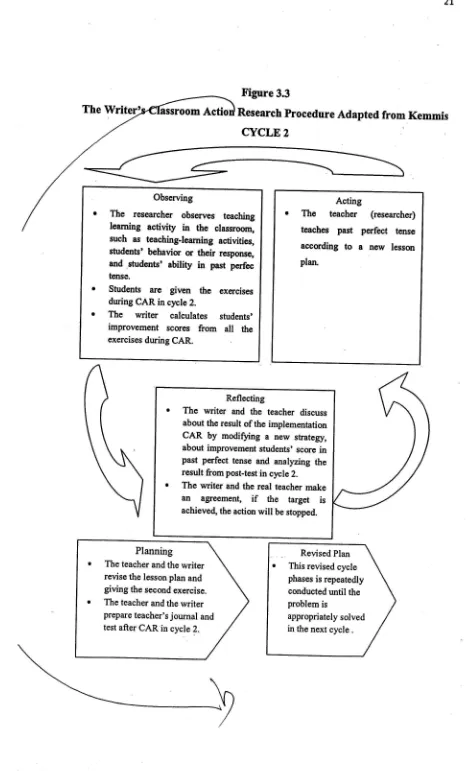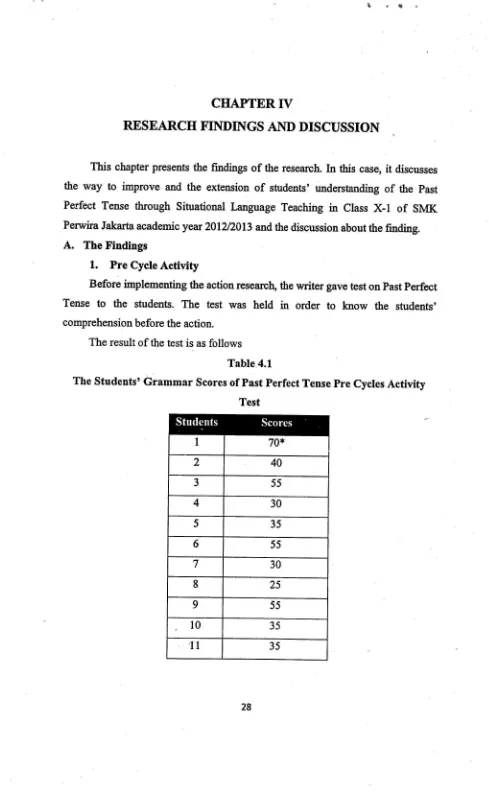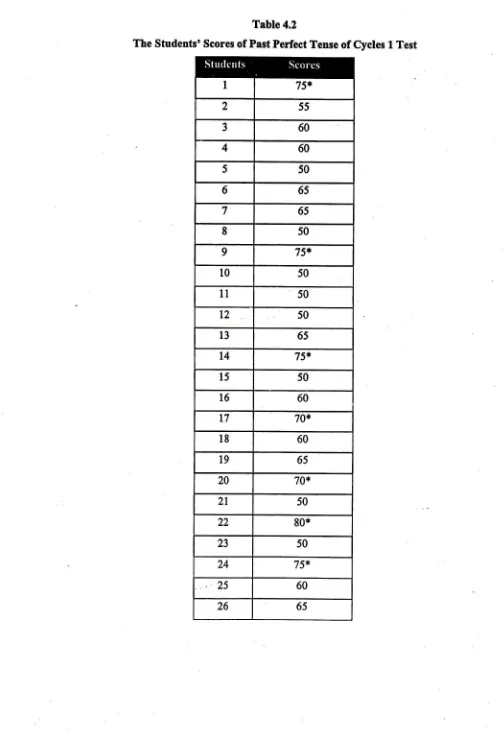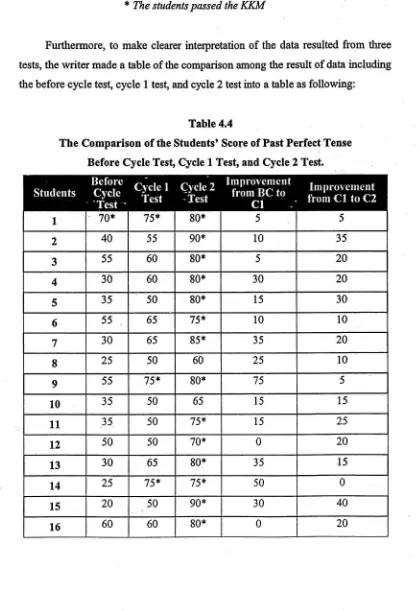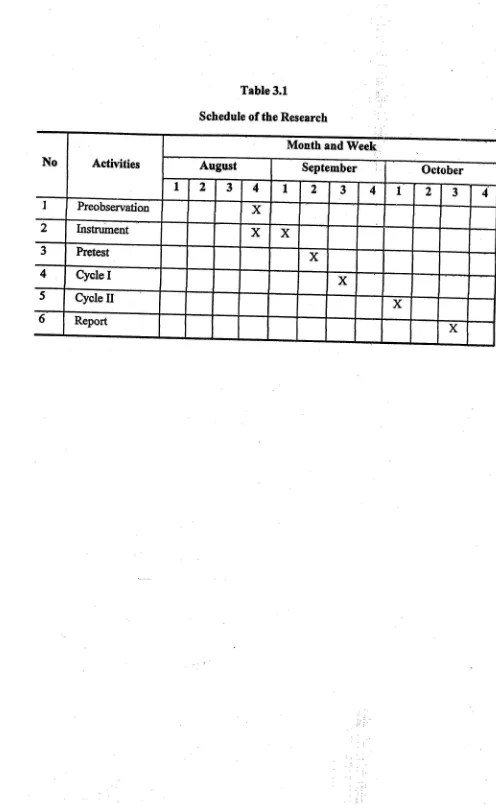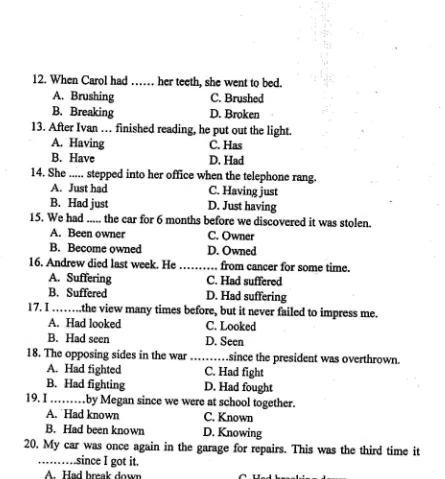Improving
Students' Understanding of the
Past
Perfect
Tense
Through
Situational Language Teaching
(A Classroom Action Research at the firct Gmde of SI,IK Perwira Jakata)
By
Azki
Erlanssa 20801400u)63ENGLISH EDUCATION DEPARTMENT
FACULTY
OF
TARBIYAH
AND
TEACHERS'
TRAINING
.
SYARIF
HIDAYATULLAH
STATE
ISLAMIC
I.NTVERSITY
JAKARTA
2015
I IIL
DEPARTEMEN
AGAMA
T.,NTyERSITAS
rSLAM
NEGERT(UIr9
SYARIFHIDAYATTILLAH
JAKARTA
FAKULTAS
ILMU
TARBTYAHDAI\
KEGURUAN
Jl. h. H. JuandaNo.95 Ciputat 15142 Jakarta
T elp: (62-21) 7 443328, 7 401925 Email: [email protected]
STTRAT
PERI\'YATAAI\
KARYA
SENDIRI
Saya yang bertanda tangan dibawatr ini,
Nama
Tempat/Tanggal lahir
NIM
Program Studi Judul Slcripsi
Azki Erlangga
Jakarta, 16 Febnrari 1990 208014000063
Pendidikan Bahasa Inggrrs
Improving
Students'Understanding of the Past Perfect Tense (A Classroom Action Research at thefirst
Grade of SMK Perwira Jakarta) Drs. Nasrun Mahmud M.Pd Drs. Nasitudin Djalil
M.Ag
Dosen Pembimbing
Dengan
ini
menyatakan bahwa skripsi yang saya buat benar-benar hasil karyasaya sendiri dan saya bertangg'rng jawab secara akademis atas apa yang saya tulis.
Pemyataan ini dibuat sebasai salah satu syarat menempuh Uiian Munaqasah.
Jakarta, 12 Mei 2015
Mahasiswa Ybs.
ENDORSEMENT SEEET
The
"skripsi'
(scientific
paper)
entitle
"IMpRovING
sruDENTs,
I.JNDERSTANDING
IN
USING PAST
PERFECT
TENSE
TTIROUGH
SITUATIONAL
LANGUAGE TEACHING
(A Classroom Action Research at the I"' Grade of SMKperyira Jakrta),
wriueri by
Azki
Erlangga,
student's registration number 208014000063 was examinedin
the examination sessionof
the
Facultyof
Tarbiyatr and Teachers'Training
Syarif
Hidayatullatr StateIslamic University
Jal@rtaon
Man D'd
2OtS.The
,.skripsi,, has been accepted anddeclared to have
ful{illed
one of the requirements for the degreeof
..S.pd,, @achelor ofArts) in
English Language Education at the English Education Deparfinent.
Jakart&
Mayt2e
2015EXAMINATION
CI{AIRMAN
: Drs. Svauki.M.pd
NIP.
19641212 1991031002
SECRETARY:Zahril
Anasv. M.HuimNrP. 19761007
20f7t0
t
002EXAMINERS:
l.Dr.
Fahrianv.
M.pd
NrP. 1970061I
l99l0l
2 0012. Drs.
AM Zainuri. M.pd
NIP.
19530304 197903l00l
by: Dean of Tarbiyah Teachers'
ABSTRACT
Azki Erlangga.2015.Improving
Students' Understandingin
Using Past PerfectTense
thnoughsituational Ianguage Teaching
(A
classroom Action
Research
in
the
X
Grade
Studentsof
sMK
perwira
Jakafia),
Skripsi,English
EducationDepartnen!
The Faculty
of
Tarbiyah and
Teachers' Training,syarif
Hidayatullah state Islamicuniversity
JalmrtaKeywords:
The
Understanding
in
Using Past Perfect
Tense,
SituationalLanguage Teaching.
This research
is
aimed atknowing
whether the shrdents' understandingin
class
X-l
at SMK
Perwira Jakartaof
the
Past Perfect Tense througbSituad;nal
Language Teaching technique.
In
addition,this research
is
alsoui-a
describehow the
implementation
of
Situational
Langrrage
Teaching
in
developing students' understanding of the form past perfect tense. The subject of thisregar.fi
isX-l
classof
sMK
Perwira Jakarta that consisted of 2g students.The method used
in
this
studyis
ClassroomAction
Research(CAR).
The classroomaction
researchapplied
in
this
study
is
a
collaborative
ClassroomAction
Research.It
means that thewriter
collaboratedwith
the English Teacherof
SMK
Perwira
Jakartaas
a
collaborator.
This
study
was
conductedfollowing
Kemmis
with
the_following
proceduresof
action
research:planning
acting, obsenring,and
reflectrng.
The study carried
out
in
two
cycles.
eu*
cycte consistedof two
meetings. The observation,interview,
teacherisjournal,
and testwere the data gathered in
this
study.The results in this study indicate that there is improvement of the students,
skill in
Past Perfect Tense.Most of the
studentsgadualty
gained good scores atthe end
of
the cycle. The
scoreof
Minimum
Mastery-Criterion
-
Kriterio
Ketuntasan
Minimal
(KKM
of
English
lesson was 70.00 (Seventy).In
the
pre-test, there were2
studentswho
passed theKKM
andthe
mean sc-oreof
pre-test was 41.60. Then,in
the result of post-testI
in
cycle one, there were 8 studentsor
who passed theKKM
consideringtheir
mean scoreof
the test gained 61.78 and Next,in
the resultof
post-test 2in
the second cycle, there were 25 students who passedthe KI(M in
which
their
mean scorederived78.2l.
The
classcondition
during teaching leaming process was quite good.In
addition, there was a positive responsefrom
the English teacher andthe
students aboutthe
implementing the action.In
conclusion, Situational Language Teachingcan improve
studenti,
of
ABSTRAK
Azki
Erlangga.
2015.Improving
Students' Understandingin
Using Past PerfectTense
through situational
LanguageTeaching
(A
chsJroom Action
Research
in
the
X
Grade students
of
SMK perwira
Jakarta),skripsi,
English
EducationDepartuent, The Faculty
of
Tarbiyah
and:Teachers, Training,syarif
Hidayatullah state Islamicuniversity
Jakar"taKata
Kunci:
Pemahaman Past Perfect Tense, Situational Language Teaching.Penelitian
ini ditujulsn
untuk mengetahui apakatr siswa di kelasX-l
SMK
Perwira
Jakarta memahami
Past Perfect
Tense
melalui
tel&nik
pengajaran Sittrational Language Teaching. Disampingitq
penelitian inijuga
ditufika;
riot*
menggambarkan kegiatao-kegratan yangdilak*an
di
kelas se6agai petatsanaandari tekhnik
pengajaranSituational
LanguageTeaching dalam
ml"i"gt
attan
pemahalran siswa terhadap bentuk kalimat past perfect Tense.Metode penelitian
ini
menggunakanjenis
Penelitian
Tindakan
Kelas (PTK);untuk
mengidentifikasi dan mengatasi pennasalalran terhadap kemampuan siswa dalarn Past Perfect Tense. Penelitianini
diawali
denganinterview
grrnrlrUry
Inggns SMK
Perwira
Jakartadan
melaksanakan pre-testdi
kehs
l-1.
Jumlah siswa dalam penelitian
ini
yakni 28 siswa
Adapun model penelitian
Kelas yang digunakan menganut pada Kernmis;iang
manaterdiri
dari empat tahapan (perencanaan, pelaksanaan, pengarnatan, daniefleksi). Ada
duajenis
dalam penelitianini,
datakuantitatif,
aantuAitatif.
Datakuantitatif
bera-qal dari hasil pre-tes dan post-tes. Seda"gkankualitatif
data diperoleh dari observasi,jurnd
gunr, dan wawaoclua. Sehingga penelitianini
termasuk kedalam penelitiandeslriptif
quantitatif.Hasil yang diperoleh dari penelitian
ini
adalah: (1) Berdasarkan hasil post-testdi siklus
l,
didapat 2jumlah
siswa yang berhasil melewatiKKM
dengan rata-rata kelas sebesar 41.60. Selanjutnyahasil
post-testdi
sikluskeduq
terdapat 25. :i r ! r
ACIC\TOWLEDGEMENT
B i s m i I I a hirrahm ani
rr
ahi mIn the name of
Allatr
The Beneficent and TheMerciful
Alhamdulillah,
the writer
thanks
to
Allah
SWT, The
lord of
the universe.He
always gives strong andfavor
in
completingthis "Skripsi" by
thetitle
"lnproving
Shrdents' Understandingin
Using
Past Perfect Tense through Situational Ianguage Teachingl'. Blessing and salvation be upon beloved Prophet Muhammad and hisfamily,
his companions, and his followers.The
writer
wantsto
thank alot to all
peoplewho
support andhelp
her. He realizes without their zupport and help, he could not finish this"Skripsi".
h
this
opportunity, thewriter would like to
express her gratitudeto
Drs.Nasrun Matunud,
M.Pd and Drs. Nasifudin
Djalil,
M,Ag.,
for
their
valuableadvice,
guidance, dedication, corrections,
ffid
suggestionsin
frnishing
this
"Skripsi".
There are also some people that the writer would like to thank to:
l.
Prof.Dr.
AhmadThib
Raya,MA.,
as the Dean Facultyof
Tarbiyah and Teachers' Training the State IslamicUniveltf
Jakarta.2.
Drs. Syauki, M.Pd., as the headof
English Education Deparfinent.3.
T.rltraril
Anasy,
M.Hum.,
as the
Secdtary
of
English
Education Departuent.4.
All
lecturersof
English Education Departnrent who have already taught the wri.ter during his study atUIN
Syarif Hidayatullatr Jakarta.5.
Drs.Ahmad fathoni, S.Pd., as the English teacherof
SMK Perwira Jakarta for his advice in teaching and doing this research.6.
Thewriter
wants to give her sincerest gratitude to her beloved parents, H.Zakaiaand
NaiyamKhoirul
Ummah,for their
support and always pray for heruntil
the Degreeof Stata-I (Sl),
who always give her strengttrsto
pass this study.
7.
All
friendsIn
departementof
English Education 20OB12OO9, EspeciallyPBI-B
(non-reg). Thanks
for
the
Advices, Kindness, Support
and Everything8.
All
peoplewho
havegiven their
he$
in writing
this
"slcripsi'that
theuriter
could not mentionit
one by one.The words are
not
oough to
appreciatefor
their help
andcontibution in
uniting
this*Skripsi",
mayAllah
SWT., bless them all.Finalln
the wr-iter rcalizesthat
this
*Stuipsf
is
not
perfect yet" Therefore, thewriter would like
to
acceptcriticism
and zuggestion from evetyone ufuo reads this ..Skripsi,,.Finalln
theuriter
expectsthis
"skipsi'will
give valuableinformation
for
development
of
education and become the inspiration for people who readit
Jakarta
Mei
2015TABLE
OF'CONTENTS
APPROVEMENT SIIEET
ENDORSEMENT SHEET
SI,RAT PERNYATAAN KARYA
SENDIRIABSTRACT
ABSTRAK
ACKNOWLEDGMENTS
TABLE
OF CONTENTSLIST
OFTABLES
LIST
OF FIGT'RESLIST
OF APPENDICESCHAPTER
I:
INTRODUCTION
A. Background of the Study B. Formulation of the Problem C.
Aim
of the ResearchD. Signifrcance of the Research
E. Organization of the Writing
CHAPTER
II:
TIIEORETICAL
X'RAMEWORI(
ul
vl11
D(
I
4 5 5 6
A. The Past Perfect Tense
I
.
Definition of the Past Perfect Tense2.
TheForm of the Past Perfect Tense...l.
DefinitionofSLT
8 8 9
11
l3
[image:8.612.47.604.18.805.2]2. 3. t4 l5 15
l5
t6
t6
l6
t7 4. 5. 6.The Objectives of SLT The Shategies of SLT
a.
Type of leandng and teaching activitiesb.
Learnerrolesc.
Teacher rolesd.
The role of insfiuctional materials The Prinoiples of SLT .The Procedures
ofSLT
The Previous ResearchCHAPTER
III:
RESEARCHMETHODOLOGY
A. Place and Time of the Study... B. The Method of Research
l.
Planning
...2.
Acting3.
Observing4.
Reflecting...E. Instumen of the research
F.
Technique of collecting data...G. Technique of Data Analysis
l8
t9
l9
2t
22 23 23 2324'
24 24 25 27 H. The Criteria of the Action SuccessCIIAPTER
TV:RESEARCII
FINDINGS AND DISCUSSIONA. The Findings
l.
Findings of the First Cyclea.
Planningb.
Aqting28 29 30 30 31 vt
xr.'
:d. Rdgsfiqg
2.
Fid&$
of&o
$M
C,Sreloa
Plaoriagb.
Aet&ry...c.
0bEonriag d" Rcflectiug B. DfuearcsiooCEAPTBR V:
COI{CLIISI$
.*Srg.WWmOU
A.Cwlusim
E. SrgBes{oil
BIBLIOGRAPEY
APTEI{DICES
3I
3X 33 33 34 14 38
vii
39
39
40
4I
*
S, : ! t i i- | ':
LIST OT'TASLES
'
Table4.1
TheRwtrtt of
Studenft' Srore Psst P€rfect Tqrse in Pre-Teet ..,..,..;.,:..,.",.. 27T$te4.2
Th€ R'esultof
Studerrtr' SmreFast P€rfectTerur€ of C5acle 1 ...3l
Table
4.3
The Restrltof
shrdents score pastpdest
Tense ofcyclc
2... 34I
{i
[image:11.612.18.601.18.817.2]LIST
OT FIGT'RES
Figur€
3.2
TheWriter's
ClasmoomAction
Rffiewh
Procedrne Adaptedfrom
Figrrre
3.3
TheWriter'g
ClassroomAction
Research Procedure Adaptedfrom
Keffinisin
Cycle 2...
... 20tx
LIST
OF
APPEI{DICES
APPENDD(
I
Schedule of theresearch....
...n...,... 39APPENDD(
4
The InsEum€NltofPre
Tet...
...45APPEI{DD(
6
The Insfiument of Post Test2
...49APPENDD(
7
Observation notes forneedanalysis...
... 50APPENDD(
8
BluePrintPre-test
...54APPENDD(
9
BluePrint Post testI
...
...57APPENDD(
l0
BluePrint Post Test2...d...
... 60CIIAPTER
I
INTRODUCTION
This
chapter presentsthe
general accountofthe
present study.It
covers backgroundof
the study, the formulationof
the problem,aim of
the research andcontibutions
of the research. A.Background
of thestudy
studying grammar
is
very
important
for
each student
of
Engtishdeparhnent Linguists have been investigating the native qreaker's knowledge
for
years,
just
asthey
have beentrying to think of
the
bestway of
describing that knowledge especiatly the grammatical system. What they have foundis
that the grammatical systemis
rule-basedand
those competent usersof
the
language'know'
these rulesin
someway.
Jeremy Harmer statesthat we
are asa
teacher must show the students what the language means and howit
is used; we must also show them what the grammaticalfomr of
the new language is, and howit
is
said and/orwritten.l
By
leaming
grammar,
we
will
be able
to
increaseour
knowledge
of
English sfiucture. So, we can makea
sentenceor
a paragraphin
good stnrcture.And
also reader or listenerwill
understand what we say.To
masterEnglish,
students should masterfour English
basicskills
andlanguage
components.The
four
English basic
skills
are listening,
reading
speakingand writing.
Meanwhile,
the
language componentsare
vocabulary, grammar, and sound.As
oneof
the
language compone,nts, grzunmarshould
be masteredby
students
becausegrarnme
enablesthem
to
use
the
language accurately.In
learning
gammar,
there
are
subjectsthat
are
called
.Tenses,. This problem makes many studentsfeel
confusedin
leaming English.But, this is
the importantthing
for
studentsto
remember when learning grammar.For
example The Past Perfect Tense. Thiskind of
tense has been taughtin
thefirst
grade of therJeremy Hanner,
senior
High school.' so,
the
X
Gradeof
senior
High school
students shouldmaster
it.
However,
to
be
able
to
communicatein
English
at the
first
time,
thestudents should
not
only
have enough vocabulary,
but
also have
masteredgrammar.
According
to
ur,
'ocrrarnmarmay
be roughly defined as the way
language manipulates and combines words
(or bits of
words)
in
orderto
form
longer units of meaning".3 There are many kinds
of
materials should be leamtby
sfudents
in
gpnrmar,
such as the Past Perfect Tense. Past Perfect Tenseis
one
of
tensewhich
studentsleam
in
the
school.But
sometime, studentsthink
that
the Past Perfect Tenseis the
same asthe
Prresent Perfect Tense that theseboth
two
tenses use
for
an action that havefinished.
Thiskind
of
tense has been taughtin
the
first
gade
of
the senior High
school.aso,
the
106 semesterof
SeniorHigh
School students should master
it
andthe
studyof
Past Perfect Tense appearsin
Krihium
Tingkat Satuan p endidikan (KTSP) 2006.Ideally, students at the
first
gradeof
SeniorHigh
School should master the past perfect tense.It
is
stated on Standardof
Competency and Basic Competence(SKKD)
in
thectrrent
curriculumKTSP
2}O6.Besides that, the students haveto
pass
the
minimum
standardof Kriteria
ketuntasanMinimwn
(KKM)
which
is
determined by ttrepolicy of
the school. TheKKM
ttrat should be attainedby
the students is 70 (seventy)However,
the
studentat the
first
gade
of
sMK
peryira
Jakartastill
frequently make some mistakes in leaming Past Perfect Tense.It
isformd that the common mistake
is
often madeby
the studentsin
using past perfect tense, suchas:
o
Jaka had watch the raid when Rama entered the roomo
The man had catch thethievi
when the policeoflicer
came Those sentences above must be written asfollowing:
o
Jaka had watched the raid when Rama entered the room'Th. M. Sudarwati and Eudia Grace, Look Ahead Bookl, (Jakarta: Erranggq zoo|), p.
l9r.
-
3Peuy Ur, Grammar Practice Activities:
A
Practicai Guide For Teachers, (New york:o
The man had cought the thieve when the policeofficer
cameThe
pastperfect
tenseis
usedto talk
about actionsthat
happenedat
or
before a certain
time
in the past. This type of tense is often used by peclple intheir
daily
life.
Thereare
3
usagesof
the
Past Perfect tense takenfrom
George E.Mshon
and JuliaM.
Burks, they are:a-
To replace the present perfect or simple past tense whe,n a direct quotation is changed into reported speech.e.g.
The lecturersai4
*I
hove studiedthe problem for years.,, The lecturer said that he had studiedthe problemfor
years.b.
In
certain sentencesto
express an unrealizedwish
that somethingin
the past had been'different. Expression such asif
only,wish
wouldrather
arecommonly
usedin
such sentences.This
useof
the past perfectwill
be studiedin
greater detail in the section on the conditional.e.g.
If
only yotrhad
toldmel
I
wishyothad
cozre with us.c.
In certain contrary-
to fact conditional sentences.e.g.
If
cleon
hadbtownthe
facts, he wourd have told you.5Accbrding
to
Betty
SchrampferAza\
the past perfect tense expresses anactivity
that was completed before anotheractivity or time
in
thepa$6
It
is
the same asthe
definition
given
by
Marcella
Frankwtro
saidthat the
past perfect tense expresses one past time before another past time.7Beside
that
verbs aredivided
it
into
trvo
kinds;
dtrative
and punctual verbs.For
durativeverb,
the past perfect tense means that an actionor
activity
continued upto
a certainpoint of time in
the past or up to the time when another actionor
activity
happened. Whereasfor
punctual verbs, the pastperfect
Tense-
.tceotge E. Wishon and Julia M. Burks, Let's Write English, (New york:Litton Educational Publishing International, 1980), p. 20g.het$
Schrampfer Azar,
i)nderstonding ond Using Engtish Granmor,(New york: pearson Educatioq 1999), p.45.'Marcella Frank, Modern English; a practical and referencesarda (New Jersey: Englewood
mear$ that an action or activity happened before a certain point of
time
in the past or before the time when another action oractivity
happened.sFrom the description above we can use
just
or alreadywith
the past perfecttense to show that the earlier action was recent or earlier than expected.
In
leaming
this
tense, students
are often
gefting
misunderstanding. Sometimes, studentsthink
that the Past Perfect Tenseis
the same as the present Perfect Tense that these both trno tenses usefor
an action that havefinished. Or
sometime the students also compare the Past Perfect Tensewith
the
Simple past Tense according to an astioninthe
past.This is caused by the
students'thinking which is
influencedin
lndonesian culture of which there is no tense for the sentencestucfires.
To
avoid students' problems, thewriter try
to find
out an appropriateway
to
improve
students' understandingof
Past PerfectTense
through
Situational LanguageTeaching
(sLT).
According
to
Jack
c.
Richard and rheodore
s.Rodgers,
situational
LanguageTeaching
is a
process aimed
at
encouragingstudent about grammar. And in
the
Designof
SLT accuracy in both prnounciation and granrmar is regarded as crucial, and errors are to be avoidedall
cost.eThe
writer
andthe
teacherwill
use ClassroomAction
Research(CAR)
which
needs collaborative tearn. For that reasons thewriter
work
collaboratively
with
the
teacherin
solving the problems through
ClassroomAction
Research(CAR).Theru
thetitle of
this research isImproving
Student,s Understanding
of
Past
Perfect
TenseBy using situational
Language Teaching
Method
(sLT),
(A classroom
action Research atclass
X-l
ofsMK
perwira Jakarta).
B.
Formulation
of theProblem
To
make the study easyto
understand, thewriter
formulates the problernas
follows:
\asrun Mahmud ,Englishfro Muslim University Students 4'h Edition, (Jakarta: UIN Syarif Hiday-atullah Jakart4 2009,p. 7 6.
eJack
l.
can
situational Language Teaching(
sLT
)
improve students' mastery of Past Perfect Tense?'
2.
can
the
teacher
who
use
sLT
method improve
their
students' achievemenUscore in past perfect tense?'C.
Aim
of
the ResearchThe aim of the research is to know whether Situational Language Teching can
improve their
understandingof
the
Past Perfect Tense subjectin
class.In
addition" the aim
of
the researchis to
desqibe the implementationof
theSLT
in
improving
students'understandingof
the Past Perfect Tense andto
describe the development of student's interestin
learning Past Perfect TenseD.
Significance of the ResearchThe contributions
of
this technique are conveyedto:
Fin!
for
the teacher.It
gives the alternative solution in teaching grarnmarskill.
Second,it
is intendedto
help
studentsto
know and understand better fundamentat analysiswhich
will
be usefulin
preparationfor their
skipsi
writing.
Thir{
is for
the National EducationDepartnent.
It
is
supportedthat
teaching
past perfect
tense
will
be
more considered in teaching learning process.E. Organization
of theWriting
This
uniting
is
divided
into five
chapters.
First
chapter
explains Introduction consistof
Backro'.rnd study, Formulationof
the problem,Aim
of
the Research, Significance of the Research andorganizationof
thewriting.
The
second
chapter
is
defined Theoretical Framework consist
of;
Definition of
the Past Perfect Tense, Thefomr of
the Past Perfect Tense, The use of the Past Perfect Tense,Definition of
SLT, The objectiveof
SLT, The Strategiesof
SLT, The Principlesof
SLT, The Proceduresof
SLT.The
third
chapteris
ResearchMethodology, consist
of
The Method
of
Research, Subject and
object of
the Study, Thewriter's
Role on thestudy, Time
Acting
Phase, Observing Phase andReflecting
Phase. Techiniqueof
Collecting
Ma5
Techniqueof Doa
Analysis, TheValidity of
Data, The Trustworttrinessof
Study and The Criteda of theAstion
Success.The fourh chaper is Research Finding corsist
of:
Before Implernenting theAction;
Rcsult
of
PreInterview,
Resultof
Preobsenation,
Resultof
PreTest
The imple,mentationof
CAR; CYCLE
1: Plamning,Asting,
Observing, R€flecting,CYCI"E
II:
Plannin&
Acting
Observing
Reflwting.
The Discussionof
the Data aftsrCAR
CHAPTER
II
THEORETICAL TRAMEWORK
In
this
chapter,the
writer
focuseson
theories relatedto
the
research.It discusses focuses on the Past Perfect Tense and SLT.A.
The PastPedect
Tense1.
Definition
of the Past Perfect TenseThe past perfect tense
is
usedto talk
about actionsthat
happenedat
or
beforea
certaintime
in
the past.And
many opinions among linguists about thedefinition of
the past perfect tense. Here thewriter
gotfour
definitions about the past perfect tense from some authors.Marcella
Frank
saidthat the
Past Perfect Tense expresses one pasttime
before another past time.
It
is the sarnewith
definition by Betty
Schrampfer saidthe
past perfect tense expressesan
activity that
was completed before anotheractivity
or time in the past.rBeside that,
Polly
Davis pointed out the past perfect tense meansthat
an action was completed before a moment of focus in the past.2In
additionverbsare
divides
it
into
two
kinds
of
verbs;
durative
and puncfual verbs.For
dtrative
verb, the past perfect tense mearu that an actionor
activity
continued upto
a certainpoint
oftime
in
the pastor
up to thetime
when another actionor activity
happened. Whereasfor
punctual verbs, the Past perfect Tense means that an actionor activity
happened before a certainpoint of time
in
the past or before the time when another action or activity happened.3
George E Wishon said that the past perfect tense is a construction made
of
had + the past participle form of the verb.a
From several definitions above we can see that the past perfect tense
is
an action or activity that complete at or before certain timein
the past. There aretwo
tAzar,op. cit.,p.39.
'Polly
Davis, English Stntcturein
Foctts, (NewYork
Newbury House publishers, 1987),p.167.3Mahmud. loc. cit.
periods of time which describe
inthe definition
of the past perfect tense. They are; an action beforea
certaintime
in
the past and an action at a certaintime
in
the past.2.
The
fom
of Past Perfect TenseMark
Foley and DianneHall
sai{
form of past perfectwith
had and a past participle which is the samefor
all person.sIn
addition the
past perfect tenseis
a
constnrction madeof
lwd
+
past pasticiple formofthe
verbFrom
the
statement above,the writer
madethe
conclusionthat
of
thepattern past perfect
tenseis
HAD
+
PAST PARTICIPLE. And there
is
noexception
for
every
person
(she,he,they,I,etc...)must
use had. These are
ttre affinnaative, negative, and interrogative pattern:a.
Afiirmative
s+Had*Past
Example:
They
hail
tahenoffbefore
youarrived
The patient had died when the doctor came
The
Abbreviation:
I
had
tl'd
Shehadl
She'dYou
had
tYofiL)He
had)
He'd
Negative
Example:
They had not
takcn ofbeforc
you arrived.Limited,2004)B.56-9
The patient had
not
diedwhenthe doctor came.c.
fntenogative
1.
Yes-No
questionfonn
Had
+
S + Pastparticipte
+...:J
Example:
Had they taken
offbefore
you arrived? Hadthe patient died ufren the doctorcame?2.
Negative interrogativeform
IIad
+ S +Not
*
Pastparticipie
+J
OR
Hadn't
+
S + Pastparticiple
+J
Example:
Had they not taken
offbefore
you arrived ?Had the patient not died when the doctor came?
OR
Hadn't they taken
offbefore
you arrived? Hadn't the patient died when the doctor came?When the past perfect tense is used
with
the question word(WH
question),it
getsdifferent
form.
For
example,from the
sentence ..Susanhad gone to
England" we can make a questionlike:
o
Who had gone toEngland?
(Subject)r
What had Susandone?
(Verb) Where had Susangone?
(Advere6
The past perfect tense can also be used
with
adverbial clauses.It
used theconjunction
like;
when,just,
before, after,
until, etc. Geoffiey
Leech and
JanSvartvik explained that when describing one event
following
anotherin
the past,10
we can show their relation
by
using the past perfectfor
the earliereven!
or
else we can use the past tensefor
both,relying in
a conjunction (e.g. after, when, etc.) to show which event took place earlier:-
When the guests had departed, Sheilalingered
alittle
while.
-
After
the
French police
had
xrccessfully used
dogs,
the
Gerrran authorities too thought of using them.73.
The Use of the Past Perfect TenseAs the
writer
explains before, the past perfect tense is usedfor
an actionor
activity that complete at or before certain time in the pastThe
pastperfect
tenseoften occurs
in
sentencescontaining
dependent clauses.The
verbin
the
main clauseis
usually
in
the
pasq andthe verb
of
the dependent clause is in the past perfect tense. In a few cases the reverse ishre.
e.g.
The teacher took my paper beforeI hadfintshedthe
test.I
had scorcelyonivedwhen I
was putright
toworks
The
pastperfect
tenseis
usedin
the main
clausewith
verbslike
hope, expect, intend,plan,
andthink.
This
tense indicatesthat the
hop",
expectation, etc., was not realized. E.g.I
had hoped (orintended,
expected) to take a vacation this summer. ButI
was forced to change my plans.eThere are 3 usages of the Past Perfect tense taken
fiom
George E. Wishon and JuliaM.
Burks, they are:To replace ttre present perfect e1 simple past tense when a direct quotation is changed into reported speech.
e.g.
The lecturer said,*I
have studiedthe problem for years.,, The lecturer said that he had studiedthe problem for years.In
certain sentencesto
express an unrealizedwish that
somethingin
the past had beendiffeient.
Expression such asdonly,
wish, wouldrather
areTGeoftey
Leech and Jan Svartvik A Communicative Grammar of English,@ngland: Pearson Education, 2002),p.7 2.
lt
used
in
such sentences.This
useof
the
pastperfect
will
bestudid
in greaterdeAil
in the section on the conditional.e.g.
If
only
youhadtoldme!
I
wishyoulwd
comewith
us.c.
In
certain contrary-
to fact conditional sentences.e.g.
If
Cleonhd
hov,nthe
facts, he would have told you.loMarcella Fraok also said that the past perfest tense used as a subjrmctive
in
if
clause andin
that
clause afterthe verb
wish
represents pasttirne.ll
It
is
thesame as the description stated by Wistronand Burks.
Durative Verbs: I had
lived
in Jakarta forfive
years in 2000Punctual Verbs: I had met him before 2000
Now
'oWishon and Burks. loc. cit. "Frank, loc. cit,
Now
I started living in Jal€rta.
1995
2000t2
Moreover, Geoffrey Leech and Jan
Svanik
said thatthe past perfect
is
a neuEal as regards the differences expressedby
the past tense and present perfect. This means thatif
we put the events describedin t2]
andt3l firther
into
thepas!
they both end up in the past perfect
lzU3a}
They
tell
me that...
the parcelarrived onApril
15fr. the parcellws
abeadyqrrived
They told me that...
the parcel hodarrivedon April l5s.
the parcel
lwd
aheadyorived
t2t
t3l
lzal
[3aI"
B.
Situational
Language TeachingGLf)
l.
TheNature
ofSituational
LanguageTeaching
Here, the
writer
gives several definitions of the SLT. According to Jack C. Richards and Theodore S. Rodgers, the theoryof
language underlying SLT can be characterized asa
tlpe of
British
"structuralism."
Speechwas
regarded as the basisof
language, and structure wasviewed
asbeing
at
the
heartof
speaking ability.13The British
theoreticians
had
a
different focus
to
their
version
of
stnrcturalism
-
thenotion
of
"situation."
Pittnan
had anotion
thatthe principal
classroom
activity in
the teachingof
English stnrcturewill
be the oral practiceof
structures.This oral
practiceof contolled
sentence pattems shouldbe given
in
situations designed to give the greatest amount of practice in English speech to the pupil.
The different thinking
about
o'stnrcturalism"from
American made
a difference techniquefor
the language teachingin
British.
From there,we
can get the situational approach based on structural view.'2Geoftey Leech and Jan svartvih
A
communicative Grammarof
English,@ngland: Peanol Educatioq 2002),p.7 l .13
By
situation Pitfrnan
meaosthe
use
of
concrete objects,pictures,
and realia,which
togetherwith
actions and gestures cao be usedto
demonsfrate the meaning of new language items.laAs a technique, SLT has the main characteristics. The main characteristics of the approach were as
follows:
1.
Language teaching begrnswith
the
spoken language.Material
is
taught orally beforeit
is presented in unitten form.2.
The target language is the language of the classroom.3.
New language points are inhoduced andpracticed situationally.4.
Vocabulary selection procedures arefollowed
to
ensure that an essential general service vocabulary is covered.5.
Itemsof
grammar are gradedfollowing
theprinciple that simple
forms should be taught before complex ones.6-
Reading
and
writing
are
intoduced once
a
sufficient
lexical
and grammatrcal basis is established.l5From the
characteristics above,we
can
seethat this
technique
more emphasizeto
the oral
approach. Students haveto
know
about the pronunciationfirst
before they turn to the written text.2.
The
Objectives ofSLT
The objectives
of the
SLT technique areto
teach a practical commandof
the four
basic
skills
of
language, goalsit
is
sharedwith
most
techniquesof
language teaching.But the skills
are approached through stnrcture.Accuracy
in
both
pronunciation and
grarnmaris
regardedas crucial, and errors are
to
be avoided atall
costs. Automaticeontol
of basic structures and sentence patterns is fundamentalto
reading andwriting
skills,
andthis is
achievedthrough
speechwork.ls
The more
important materials
to
be
taught
which we get from
the explanation above are"Pronunciation"
and"Grammar".
when we
haveknown
t4
about
the
pronunciation
and the
structure
of
the word
or
sentence,we
canautomatically do both reading and
writing
skills.3.
The
Strategies ofSLT
Basic to the teaching
of
Englishin
SLT is a stnrctural syllabus and aword
list.
A
stnrctural syllabusis
alist
of
the basic structures and sentence pattemsof
English, arranged accordingto their
orderof
presentation.In
SLT,
structures are always taughtwithin
sentences, and vocabulary is chosen according to howwell
it
enables sentence pattems to be
taught
a*
Typeof Learring
and Teaching activitiesSLT
employsa
situational
approachto
presentingnew
sentence patterns and a drill-based manner of practicing them.The
practice
techniquesemployed generally consist
of
guidedrepetition
and
substitution
activities, including
chorus
repetition,dictatioru
drills, and contolled
oral-basedreading
and
writing
tasks.Other oral-practice techniques are sometimes used, inctuding pair practice and group work.
b.
Learner rolesIn
the
initial
stagesof
leaming, the
leameris
requiredsimply
to listen and repeat whatthe
teacher says andto
respondto
questions and commands- The leamer hasto conhol
over the contentof
learning and isoften
regardedas
likely
to
succumbto
rmdesirable behaviors unlessskillfully
manipulated by the teacher.c.
TeacherrolesThe teacher's function is threefold.
In
the presentation stageof
the lesson,the
teacher serves as amodel,
settingup
situationsin
which
theneed
for
the target
structure
is
createdand then
modeling
the
new structurefor
studentto
repeat. Thenthe
teacher becomesmore
like
the15
l)
Timing;
2)
Oral practice, to support the textbook structures;3)
Revision (i.e., review);4)
Adjustnent
to special needs of individuals;5)
Testing;6)
Developing
languageactivities
other than
those
arising from
the textbook.lTd.
The roleof
instnrctional materialsSLT
is
dependentupon both
a
textbook and visual aids.
Thetextbook
contains
tightly
organized
lessonsplanned around different
grammatical stnrctures.Visual
aidsmay be
producedby
the
teacher
or
may be commercially
produced;they
consistof
wall
charts, flashcards, pictures, stick figures, and so on.l84.
ThePrinciples of
SLT
The origins
of
this
approach beganwith
the work
of
British
appliedlinguists
in
the
1920sand
1930s.Two
of
the
leadersin
this
movement werePalmer and
HornbY,two
of
the
most prominent figures
in
British
(twentieth century) language teaching. What they attempted was to develop a morescientific
foundationfor
an
oral
approachto
teachingEnglish
thanwas
evidencedin
theDirect
Technique-The result was
a
systematic
study
of
the
principles
and procedures thatcould
be appliedto
the selection and organizationof
the contentofa
langu4ge course.5. TheProceduresofSLT
Classroom procedures
in
SLT vary according to thelevel of
the class, but-
procedures at any
level
aim to move from controlled to freer practiceof
structures andfrom
oral useof
sentence patternsto their
automatic usein
speech, reading,. anduriting.
"Ibid,,p.37
lsRichard.
16
Richards and Rogers give detailed
information
about teaching procedtnes to be usedwith
SLT. The sequences of activities they propose consist of:a-
Listening practicein
which
the teacher obtainshis
student's attention and repeats an exampleof
the pattemsor
aworld
in
isolationclemly,
several
times,
probably
saying
it
slowly
at
least
once (where. . ..is. . ..the.. ..pen?), separating the words.b.
Choral
imitation
in
which
studentsall
togetheror
in
large
groups repeat what the teacher has said. This works bestif
the teacher gives aclear instnrction
like
'tq)ea!"
or
"everybod/'
and hand signals to
mark time and strress.
c.
Individual imitation
in
which the
teacher
asks
several individual
students
to
repeatthe
model
he
has
given
in
order
to
check their
pronrmciation.
d.
Isolation,
in
which
the
teacher isolates sounds,words
or
groupsof
wordswhich
causie trouble and goes through techniquesl-3 with
them before replacing themin
context.e.
Building
upto
a new model,in
which the teacher gets studentsto
ask and answer the questions using pattems they alreadyknow
in
orderto
bring about the information necessary to introduce the new model.f.
Elicitation,
in
which the teacher, using mime, prompt words, gestures,etc., gets
studentsto
ask
questions,make
statements,or
give
new examples of the pattern.g.
Substitution
drilling
in
which the
teacheruse
cue words
(words, pictures, numbers, names, etc.)to
get individual
studentsto mix
the examples of new patterns.h.
Question-answerdrilling,
in which the teacher gets one student to ask e question and anotherto
answeruntil
most
studentsin
the class have practiced asking'and answering the new question form.t7
simply correct
the
mistake himself.
He
gets
students
to
correctthemselves
so
they
will
be
enco,raged
to
listen
to
each
other
carefully.leIt
wasjust
one exampleof
procedureswhich
is
SLT used.In
addition,to
help the
teacherapplied
this
technique, he/shehas had
the
teacher,s
kit,
a collectionof
items and realia that canbe used
in
situational langrrage practice,is
hence an essential partof
the teacher,s equipment.2oProcedures associated
with sLT in
thefifties
and sixtiesare an extension and
fi[ther
developmentof
well-established techniques advocatedby
proponentsofthe
earlieroral
Approach in theBritish
schoor of language teaching.C.
The previous researrchsome
previous
researchstudies
on
error
analysisrelating
to
English
grammarhave
been conductedby
sorne researchers.
First,
obi
studied
aboutulmproving
students' understanding
of
the
past
perfect
Tense
Throughsituotionat
Longuage Teaching:a
classroom AcionResearch
ot
thetil
Grade o7M4
Islamiyah
ciputat".
Thefindings
of
this
study show
thafl
(t)
basedon
the resultof
the
test;there
was 20.2gyo improvementof
students, mean after using Situational Language Teaching"Ibid.,p.4l
CHAPTER
Itr
RESEARCH
METHODOLOGY
This chapter discusses the place and time of the research, the method of the research,
the
subjectthe
research,the
research instrume,nts,the
techniqueof
collecting data, the technique
of
the data analysis, and ttre criteriaof
the actionsuccess.
A.
The Timc and Place of the StudyThe place
of
the research wasat
sMK
pem'ira Jakarta,in
the first
year studentsof
X-l
class, academic yearz|Dnu3.
This research had been carriedout for 3 (three) months started from Januari up to Maret 2013.
B. The Method of the Research
The
methodthat the writer
usedin
this
research was Clasroom ActionReasearch (CAR) from Kurt Lewin. The design is as following: 3.1
in's Action Research Design'
Refbc
€e
ilPhn
/-l
,\7
::
Phnfl
\]
:
BeIletr
q
Arl
r=
-tt---/ )
w
20
[image:32.612.83.562.60.791.2]Based on Kemmis' action research design above, the writer adapted from the research design from cycle
I
to cycre 2 desigued by Kemmis, as follows:Figure 3.2
The
Writer's
Rilsearch Procedure Adaptedfrom
KemmisCTCLE
1Observing
r
The researcher and the real teacherobserves teaching learning aaivity in
the
classroom, such asteaching-learning activities, students, behavior or response
r
Identifies the students' achievement in leaming past perfect tense by giving the enercise before CAR in cycte l.The
writer
calculate students'improvement scores from the exercise during CAR
in
cylceI
whetrer improvins or not.Reflecting
r
After observation process is dong theresearcher and the teacher make a
reflection to waluate teaching leaming process and
the
improverrent of students' past p€rfect tense.o
The teacher and the writer prepare thelesson plan
fa
the noct rycle and for test after CAR in cycle Z in order to know improvernent of students' scoe and to solve the problem unfinishedActing
o
In this CAR, the writer acts asthe teacher and the real teacher is monitoring and observing ttre
class condition. The teacher
conducts
the
lesson plan, teaches past perfect tensgexplains
the
schernatic strucfures..
After interviewing, observingand conducting test before CAR. The researcher and the
real teacher make instruments, such as: lessonplan, teacher's
joumal, and test during CAR.
Revised Plan
r
This revised cyclephases is repeatedly
conducted until the problem is
21
Observing
.
The
researchcr observes teaching leaming activityin
thc classroom, zuch as teaching-leaming activitics, students' behavior or their responsc,and students' ability
in
past perfcctcnse.
r
Studentsare
giventhe
exercises during CAR in cycle 2. [image:33.612.87.557.39.810.2]r
The
writer
calculates sfudents' improvement scores fromall
the exercises during CAR.Figure 3.3
Research Procedure Adapted from Kemmis CYCLE 2
Acting
o The
teacher (researcher) teaches past perfect tense accordingto a
ncw lesson plan.Reflecting
.
The writer and the teacher discuss about the result of the implementationCAR by modifuing a new shategy, about improvement students, score in past perfect tense and analyzing the result from post-test in cycle 2.
r
The writer and the real teacher makean
agreement,if
the
target is achieved, the action will be stopped.Planning
r
The teacher and the writerrevise the lesson plan and giving the second exercise.
o
The teacher and the writerprepare teacher's journal and test after CAR in cycle 2.
,
Revised Plan.
This revised cyclephases is repeatedly conducted until the problem is
22
The
classroom action research designin
this
study
is
a
collaborative classroom action research. In conducting the research, the researcher collaborated with the real English teacher of SMK Perwira Jakarta as a collaborator. The writer played a role as an English teacher who teaches past perfect tense through SLT to the students. The researcher was not only as an observer but she also took actionsby
making lessonplan
andglving
assessment.Then,
she also collected and analyzed.data to know the result of students, past perfect tense.C.
Research ProcedureThis study is classroom action research; it means that there must be cycles
in
this study. Therewill
be 2 cycles and each cycle is ended by final test. Thereare 4 steps in action research. They are planning, acting, obsenring, and reflecting. Before entering the cycle, the reseacher found an institution as an object
of
research
to
conduct preliminary interviewto
the
English
teacher.First,
theresearcher met the English teacher and
alked
about his method when he teacheshis
students.In
this
activity the
teacher taught studentsusing
conventional method. He used ZK,S and English handbook to teach his students. The teacheralso said that he felt difficult to teach writing in the class and the students have the
problems in writing. After the researcher got the data from interview and the test,
the
researcher decidedto
analyze the problems facedby
the
students.After
analyzrng the problems faced
by
students, the next stepwhich
is
doneby
the researcheris
designing a planto
continue into the next cycleto
overcome the problem in the previous cycle. After conducting pre cycle research, the researchermoves to the next phase, involving: plaruring, acting, observing and reflecting
1.
Planning PhaseIn planning phase, the writer and the teacher shared the information. The writer identifies and diagnoses students'problem in past perfect tense occurred in
the
classroom provenby
interviewingthe
teacher.It
covers determining the technique, designing lesson plans, and setting the criteria of success.23
lesson plan based on the recent used syllabus. The writer described the project or activity that she designed for her students by preparing lesson plan and appMng
lesson plan
in
first grade class at SMK Perwira Jalorta. The lesson plan includedthe
following
items: specific instuctional objectives, the instructionai materialsand media, procedure of presentation, and procedure of assessment. In setting the criteria of success, the researcher determined the criteria of the action success.
It
isuseful for measuring whether the action of this study is zuccessful or not.
2.
Acting PhaseIn
this phase, the researcher carried out the planned action. In this phasethe lesson plan that has been discussed, would be implemented by the researcher.
In implementing the action, the writer acts as the English teacher who taught past
perfect
tensethrough
situational languange teachingand
she
observes the students'activities
after using
situational language teachingin
the
ciass.Meanwhile, the real English teacher acts as the collaborator who monitoring that
happened
in
the teaching and leaming process. This phaseis
hoped could solvethe students'problem.
3.
Observing PhaseIn this phase, the researcher observes
cAR
process of leaming past perfecttense
by
using situational
language teaching.The
important
aspectsin
observation are sources of data, the instrument used in collecting the data, and the technique for data collection.
4.
Reflecting PhaseThe
writer
andthe
English teacherwho
play a role
as observer and24
there
will
not be the next cycle. Meanwhile,if
the resultof
the aotion does notreach the criteria of success, so the next cycle needs to be done.
It
should move tothe next cycle regarding re-planning, re-acting, and re-observing.
C. The Participants
1. The Participants
The participants were students at grade
l0th,
the classX-l
of SMK Perwira Jakarta, academic year 2012t2013. Mostof
the students atclass
X-l
have the lowest achievementof
the
grammar subject.For that
reason,they
need an appropriate techniqueto
help them improve their scores. test among the other10th grade classes.
D. The Instruments of the Research
The writer
used
some instrumentsto
collect
data
and
here
are
the instruments that he uses:a. Test
The test meant of this research was multiple choice items. The test items or
the number of the questions items were 20.
b.
Observation sheetsIn gathering data the writer and the teacher took field notes. The writer and
the teacher should note down any information about the activities of the leamers,
the
affitudesof
the
students,the
teacherway
of
tssshing,
and the
class atnoospheres duringfts
implementation of CAR.E.
The Technique of Collecting Data25
interview to be presented for the teacher, and quantitative data which uses pre-test and post-test.2 It would be explain as follows:
a.
ObservationIn this oase, the writer uses check list for observation.
It
would be about the teacher's performance during Classroom Action Research (CAR), class situationas learning activity
of
the Past Perfect Tense, and students' response concerning the useof
the
SLT technique.And
thewriter
also hasto
make sure that the lmshing learning process is in line with the lessonplans..b.
TestIn this study, the test used here is multiple choices form. The tests used are
pre-test and post-test for this study. The pre-test is done before implementing SLT technique. And the post-test is implemented afterusing SLT technique.
F.
The Technique of Data AnalysisThe technique
in
analyzing non numerical datathe writer
usedin
this study was the observation of students' aetivities during teaching learning processin conducting classroom action research (CAR). The writer used field notes sheet.
The example of the field notes sheet is as following:
There were 4 columns in the field notes sheet, and each of the columns has
its
own criterion to be noted by the observer.It
may be students' activites, the teacher's performance, and class situation as grammar activity during Classroom Action Research (CAR), and comments from the observer.[n
general,all
of theneed aspects that should be noticed are to make sure whether the teaching learning
process in line with the lesson plans or not.
The technique
in
analyzing numerical data, first thewriler
triesto
get theaverage of students' score per action in pretest, posstestl, and posttest2.
It
is usedto know how
well
students' score as a whole on the past perfect tense.It
uses the formula:3' Ibid.,p. 127
-
l3z.3Ating Somantri and Sambas Ali Muhidin, Aplikasi
26
X
: meanx
: individual scoren
: number of studentsTheq
thewriter tries
to
getthe
class percentagewhich
passthe
KKM
considering English subject gains score
70
(seventy)which
is
takenfrom
the school agree,ment at Senior High schoolof
SMK
Perwira Jal€rta. The formulaused herc is:a
F
P
=-](l00yo
N
P
: the class percentageF
: totalpercentage scoreN
: number of studentsAfter
getting meanof
students' scoreper
actions,the
writer
identifies whether thereis
improvementof
students' scoreon the
past
perfect tensecomprehension or not from pre-test up to posttest score in cycle
I
and cycle 2.In
analyzingthat, the writer uses the formula:s
vl
'v
P
=-X
100%v
P
: percentage of students' improvementy
: pre-test resultyl
: post testI
aAnas
Sudijono, Pengantar Statistis Pendidikan, (Jakarta: PT. Raja Grafindo Persada,2007), p.43.
tDauid
E. Meltzer, The Relationship between Mathematics Preparation and Conceptual Learning Gains
in
Physics: A Possible Hidden Yariable in Diagnostic Pretest ,Scores, (Iowa: Department of Physics and Astronomy, 2008), p. 3,II
)(
27
y2
-y
P
=-
xluoo/o
v
P
: percentage of students'improvementy
: pre-testresulty2 : post-test 2
G.
Criteria
of the Action SuccessClassroom Action Research is success
if
it can attain the criterion which hasbeen determined.
In this
study, the researchwill
succeed when thereis
75% ntrmbersof
students could achieve some improvement scores from the pre-testuntil
the second post-testin
cycle two and/or they could pass the target scoreof
the minimal mastery level criterion (KKM).6 The
KKM
that must be attained is 70(seventy)
which
is
adapted from the school agreement (Srvu< perwira Jakarta)would
be
stoppedif
the
criterionof
the
action success achieved,but
if
this condition has not been reached yeg the alternative action would be donein
the next cycle until the criterion of the action can be achieved.CHAPTER
TVRESEARCH FINDINGS AND
DISCUSSION
This chapter presents the findings
of
the research.In
this case,it
discussesthe
way
to
improve andthe
extensionof
students' understandingof
the past Perfect Tense through situational Language Teachiirgin
class
X-l
of
SMK Perwira Jakarta academic year 201212013 and the discussion about the finding.A.
The Findings1.
Pre CycleActivity
Before implementing the action research, the writer gave test on Past Perfect Tense
to
the
students.The
test was
held
in
order
to
know the
students,comprehension before the action. The result of the test is as follows
Table 4.1
The students'
Grammar
scores of Past perfect Tense pre cyclesActivity
Test
[image:40.612.92.581.30.840.2]29
t2
50l3
30t4
25l5
20t6
60t7
6518 30
l9
2520 60
2l
3022 70*
23 45
24 60
25 30
26 3C
27 35
28 35
IJ
x=-n
41.60
*
I'he students passed theKKM
From the table above and the result
of
the calculated score,it
can be seenthat most
of
the students could not pass theKKM,
and only twoof
the studentscould pass the
KKM. It
was only7.l4% of students passing theKKM.
Therefore,from
the data, thewriter
decided to begin his researchin
improving students' understanding of Past Perfect Tense tkough SLT.30
In this phase, the writer and the teacher made a planning for the action based
upon the problems faced
by
shrdents of the Past Perfect Tense.ln
this case, the writer determined the selected material and activity for the teacher based on SLTtechnique into a lesson plan. And also he made the exercise which is appropriate
to
SLT
techniques. Besideof
making lessonplan,
the writer
also prepared unsbuctured observation sheet to observe the students' and the teacher' activities i11 f@shing learning process yhether it wasin
line with the lesson plan had made before or not. And the writer also prepared the post test 1to
collect the data; toknow
whether there are some students' improvement scoresfrom
pretest toposttest.
b.
ActingThe teacher implemented the teaching learning process based on the lesson plan hacl been made. Here, after the teacher started to extend what materials to be
leamed by students, the teacher began to explain the
definitio&
the form and theuse
of
the Past Perfect Tense.After
that, the teacher gave some examples and asked themto
change the sentence into negative and questionfonns'
Then,in
order
to
makeit
surethat
students understand aboutwhat
the
teacher had explained, the teacher asked them to make a sentence using the words givenby
her. Later, to know howwell
shrdents' understandingof
the Past Perfect Tense' the teacher explainedffstly
what the Past Perfect Tense is and how to useit
thenthe
teacher asked studentsto do
some exercises.This
task was doneby
thestudents individuallY.
c.
Observing31
sentence that many students
still
gettingdifficult to
doit.
Meanwhile, the class siiuation wasstill
undercontol.
It
means that someof
studentsstill
did not pay attention to the teacher's explanatioo, and they also cheated each other when they were asked to make a sentence and the teacher even ignored theirbehavior.d. Reflecting
The
writer
and the teacher discussedthe
conclusionof
implementing theaction.
Theq they tried
to
modiff the
a

